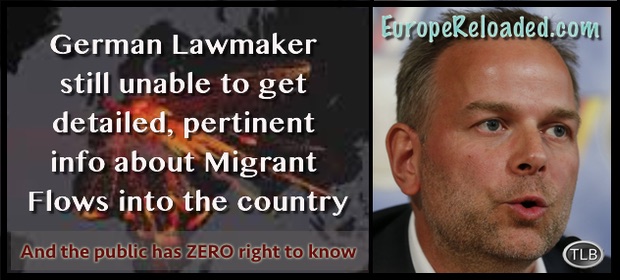
ER Editor: We also recommend this short Paul Joseph Watson piece from last month titled German Government Classifies as Secret Number of ‘Refugees’ Arriving By Plane. We also link to a piece we published from March 2018 on migrants coming into Germany in relative secrecy by plane, titled Germany: One-Third of Migrants Arrive Covertly. Here is G. Edward Griffin’s introduction to that piece:
A member of the German parliament discovered that nearly one-third of adult migrants are arriving in Germany by plane from Turkey, Greece, and Italy. This violates the ‘Dublin Regulation’ agreed to by these countries that requires asylum seekers to apply for protection in the first country where they land. Since there are no flights from the countries-of-origin of these immigrants, they had to board aircraft in countries into which they migrated first. There also is the question of who is paying for their plane tickets and putting money into their pockets? These questions are leading to the discovery of massive deception and corruption.
********
Migrant arrivals by plane in Germany classified as ‘secret’
The German Federal Government still refuses to publish information on how many refugees come to Germany by plane. Corresponding figures were demanded several times from the authorities by the AfD member Leif-Erik Holm (pictured).
BERLIN – The deputy parliamentary leader of the AfD in the Bundestag has been working on this topic for a long time, as the Federal Office for Migration and Refugees (Bamf) has been interviewing numerous asylum seekers about their itineraries since 2017.
 It is also about the question of how the refugees came to Germany – on foot, by train, by car, bus or plane. A question from the deputy AfD group leader revealed last year that just under a third of all interviewed refugees said they had arrived by plane.
It is also about the question of how the refugees came to Germany – on foot, by train, by car, bus or plane. A question from the deputy AfD group leader revealed last year that just under a third of all interviewed refugees said they had arrived by plane.
When Holm recently inquired about the latest figures, he was given the answer that they were now classified as a secret “(VS) – only for official use” – for reasons of “state welfare”. This means that the AfD member may see the numbers in the Parliamentary Secretariat of the Bundestag, but he must not make them public – and the general public should not know the extent of the arrivals.
Since Holm did not want to accept that, he checked with the Federal Government again and asked for the reasons for their secrecy. But the Interior Ministry continues to stonewall the deputy. The travel route survey is now being standardized for all applicants who are older than 18 years old, according to Parliament Parliamentary State Secretary Stephan Mayer (CSU).
The findings from this would be used to analyze migration movements on the main routes to Germany. In addition, the travel route survey may also be included in the decision process regarding respective asylum applications.
“Disclosing the evaluation of the itinerary survey could provide information on the specific questions raised in the survey, which are the core component of the asylum hearing,” the official response given to Berlin weekly Junge Freiheit, noted.
But Holm did not just want to know how many refugees flee directly to Germany, but also how many ever used a plane on their entire journey. Finally, it is conceivable that asylum seekers – for example from Africa – first fly to France and from there continue by train or bus to Germany. Once there, they then apply for asylum.
But even here, the Federal Government refused to comment. The itinerary was designed to gather “evaluable route information and ‘modi-operandi,” was the brief answer. “A detailed answer to the first part of the question would provide information about the specific questions posed in the survey. This information is especially worthy of protection.”
According to Holm, the government wants to sweep the impact of immigration on the social system under the carpet.
He says he cannot understand the decision of the Interior Ministry. “What is so secretive and worthy of protection for questions that have already been asked to thousands of asylum seekers in the context of the itinerary? The asylum seekers have certainly made no secret of the questions among themselves. The behavior is completely incomprehensible.”
The question of how asylum seekers illegally arrived in Germany is the key issue of the entire asylum crisis. After all, it’s also about which neighboring countries could simply wave refugees through. “In particular, the question of whether an aircraft was used on the entire itinerary to Germany is very significant in this context,” Holm added.
Those who have enough money to fly to Europe comfortably by plane can hardly be a destitute refugee.
“It is just about the usual welfare state immigrant. And that is exactly what the federal government wants to sweep under the carpet.”
************
Original article
••••
The Liberty Beacon Project is now expanding at a near exponential rate, and for this we are grateful and excited! But we must also be practical. For 7 years we have not asked for any donations, and have built this project with our own funds as we grew. We are now experiencing ever increasing growing pains due to the large number of websites and projects we represent. So we have just installed donation buttons on our websites and ask that you consider this when you visit them. Nothing is too small. We thank you for all your support and your considerations … (TLB)
••••
Comment Policy: As a privately owned web site, we reserve the right to remove comments that contain spam, advertising, vulgarity, threats of violence, racism, or personal/abusive attacks on other users. This also applies to trolling, the use of more than one alias, or just intentional mischief. Enforcement of this policy is at the discretion of this websites administrators. Repeat offenders may be blocked or permanently banned without prior warning.
••••
Disclaimer: TLB websites contain copyrighted material the use of which has not always been specifically authorized by the copyright owner. We are making such material available to our readers under the provisions of “fair use” in an effort to advance a better understanding of political, health, economic and social issues. The material on this site is distributed without profit to those who have expressed a prior interest in receiving it for research and educational purposes. If you wish to use copyrighted material for purposes other than “fair use” you must request permission from the copyright owner.
••••
Disclaimer: The information and opinions shared are for informational purposes only including, but not limited to, text, graphics, images and other material are not intended as medical advice or instruction. Nothing mentioned is intended to be a substitute for professional medical advice, diagnosis or treatment.
••••
Click on the image below to visit TLB Project on twitter …




